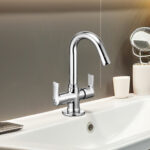In the realm of interior design and functionality, one often overlooked yet indispensable component is sanitaryware. From bathrooms to kitchens, sanitaryware items play a crucial role in enhancing the aesthetics and functionality of spaces. In this blog post, we will explore the importance of sanitaryware items, their usage benefits, and other key factors that contribute to their significance in modern living spaces.
Essential Components of Functional Spaces:
Sanitaryware items encompass a wide range of fixtures and fittings that are essential for maintaining hygiene and functionality in spaces dedicated to personal care and cleanliness. Key components include toilets, basins, bidets, urinals, and bath fixtures. These items collectively form the backbone of functional bathrooms and kitchens, ensuring a seamless and hygienic experience.
Aesthetic Enhancement:
Sanitaryware items are not just utilitarian; they also contribute significantly to the aesthetics of a space. The design and style of these fixtures can transform a mundane bathroom or kitchen into a visually appealing and cohesive environment. With a plethora of designs, shapes, and finishes available, sanitaryware allows homeowners to express their individual tastes and preferences, turning these functional spaces into stylish sanctuaries.
Hygiene and Cleanliness:
The primary purpose of sanitaryware is to facilitate hygiene and cleanliness. Toilets, basins, and bidets are designed with smooth surfaces and easy-to-clean materials, reducing the risk of bacterial buildup. Modern advancements in sanitaryware technology include features such as rimless toilets, which eliminate hidden areas where germs can accumulate, ensuring a more hygienic environment.
Water Conservation:
Sustainable practices are increasingly becoming a priority in contemporary design. Sanitaryware manufacturers have responded to this demand by developing water-saving technologies. Dual-flush toilets, low-flow faucets, and water-efficient showerheads are examples of how sanitaryware contributes to water conservation. Homeowners looking to reduce their environmental impact can opt for these water-saving fixtures without compromising on performance.
Comfort and Functionality:
The design of sanitaryware is not only about aesthetics but also about ensuring user comfort and functionality. Ergonomically designed toilets and basins, along with features like soft-close toilet seats and easy-to-use faucets, enhance the overall user experience. These considerations make daily routines more comfortable and contribute to the overall usability of the space.
Smart Technology Integration:
In the era of smart homes, sanitaryware is embracing technology to offer enhanced functionality. Sensor-operated faucets, touchless flush systems, and temperature-controlled shower systems are examples of how smart technology is integrated into sanitaryware. These innovations not only provide convenience but also contribute to water conservation and hygiene.
Accessibility and Inclusivity:
Another significant aspect of modern sanitaryware design is a focus on accessibility and inclusivity. Height-adjustable toilets, grab bars, and barrier-free showers are designed to accommodate individuals with diverse needs, including those with mobility challenges. This inclusive approach ensures that sanitaryware items cater to a wide range of users, promoting universal design principles.
Easy Maintenance:


Sanitaryware items are designed with ease of maintenance in mind. The smooth surfaces and high-quality materials resist staining and are easy to clean. This reduces the time and effort required for upkeep, making sanitaryware a practical choice for busy households where convenience is paramount.
Market Trends and Customization:
The sanitaryware market is dynamic, with constant innovations and evolving design trends. Manufacturers offer a wide range of styles, colors, and finishes to cater to diverse consumer preferences. Customization options allow homeowners and designers to create unique and personalized spaces, ensuring that sanitaryware seamlessly integrates with the overall design theme of the home.
In conclusion, sanitaryware items are integral to the functionality, hygiene, and aesthetics of modern living spaces. Beyond their utilitarian purposes, these fixtures contribute to sustainability, comfort, and inclusivity. The evolving trends in sanitaryware design, coupled with advancements in technology and materials, offer homeowners a myriad of options to create spaces that are not only functional but also reflect their styles and values. As the intersection of design and functionality, sanitaryware items play a vital role in elevating the overall quality of our living environments.






